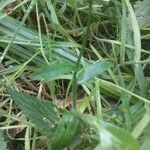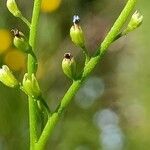Stoloniferous perennial, often short-lived. Stems decumbent or erect, ascending to c. 45 cm, ± hairy. Lower lvs almost sessile, to 10 × 2 cm, oblong to oblong-lanceolate, clothed in appressed hairs, especially above; apex usually obtuse. Upper lvs smaller and narrower. Cymes ebracteate, elongating greatly after flowering. Pedicels becoming 1-2× length of calyx at fruiting. Calyx 1.5-3 mm long at anthesis, clothed in straight appressed hairs; teeth accrescent, ± triangular, c. ⅓ length of calyx tube at anthesis. Corolla limb 5-10 mm diam., flat, blue with yellowish throat; lobes emarginate. Style ± = calyx tube. Nutlets 1.2-1.6 × 1-1.2 mm, ovoid, obtuse, glossy black or dark brown, with narrow rim.
Fibrous-rooted perennial 2–6 dm, often creeping at base and commonly stoloniferous, inconspicuously strigose; lvs 2.5–8 cm × 7–20 mm, the lower mostly oblanceolate, the others more oblong or elliptic to lance-elliptic; infl terminal, becoming open; mature pedicels spreading, about equaling or somewhat surpassing the 3–5 mm cal; cal closely strigose, the lobes equaling or shorter than the tube, sometimes unequal; cor blue, the limb 5–10 mm wide, flat; style equaling or more often surpassing the nutlets, rarely surpassed by them; 2n=64. Shallow water and wet soil; native of Europe, naturalized throughout our range. May–Sept. (M. palustris)












